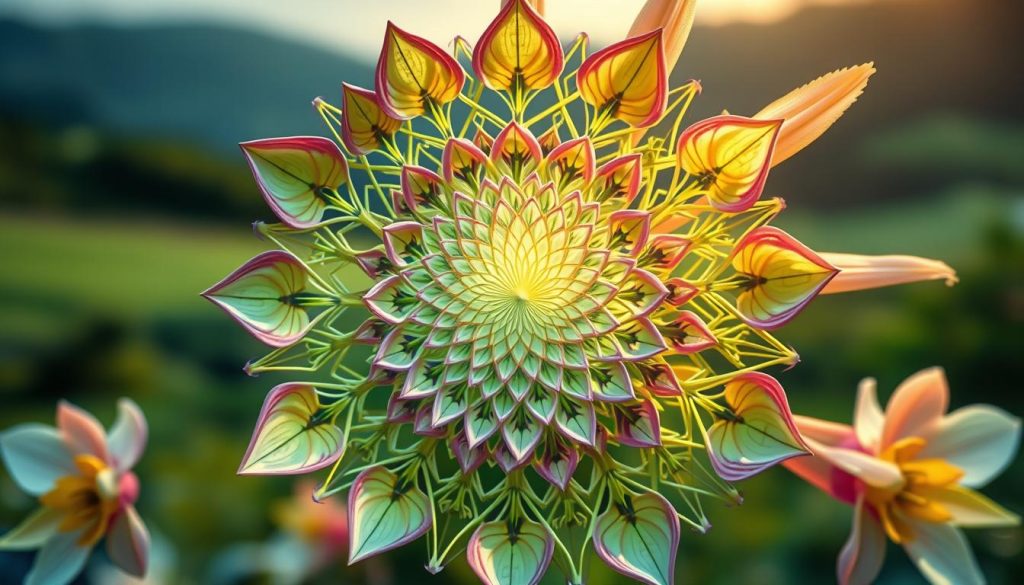We open a door to a way of seeing that links math, nature, and meaning. Galileo’s line—mathematics is the alphabet with which God has written the universe—sets the tone.
Across time, cultures carved shared blueprints: flower motifs at Abydos, pyramids aligned to stars, and Ohio earthworks mapped to lunar cycles. These echoes show that shapes and ratios carry practical wisdom.
Look around: hexagonal snowflakes, honeycombs, spirals in shells and sunflowers. Simple forms become tools for focus, calm, and creative play. We’ll explore hands-on ways to use these symbols to tune attention and steady the nervous system.
Key Takeaways
- Patterns in nature and ancient sites point to shared design principles we can study and use.
- Simple shapes—circles, triangles, spirals—serve as practical anchors for daily focus.
- Historic monuments and natural forms mirror ratios that bridge science and spirit.
- Short, playful practices can help you tap calming energy and spark creativity.
- We’ll translate this wisdom into easy tools for home, work, and art.
Why Sacred Geometry Matters Today: Intent, Benefits, and How This Guide Works
Symbols of order appear across cultures as practical tools for shaping attention and space. We frame these lines and curves as a modern toolkit you can use at home, at work, and on quiet days.
Our intent is simple: use principles sacred geometry to bring clarity, ease, and focus—without mystery or gatekeeping. You’ll find short practices and clear steps that fit 5 minutes or less.
Benefits are real and simple. Expect steadier attention, calmer breath, more creative flow, and kinder contact with your own energy and surroundings.
- Quick wins: visual anchors for meditation and micro-habits.
- Symbol matching: circle for wholeness, triangle for balance, square for grounding.
- Daily stack: pick a shape, set one-line intention, pair with breath, close with gratitude.
| Goal | Recommended Shape | Practice (1–3 min) | Result |
|---|---|---|---|
| Safety & Grounding | Square | Breathe steady for 3 cycles while tracing edges with gaze | Calmer nervous system |
| Stability & Focus | Triangle | Set a single intention; inhale at base, exhale to apex | Clearer priorities |
| Boundary & Ease | Circle | Visualize a soft ring around you during a short meditation | Stronger personal limits |
We move with a gentle loop: observe, select, activate, integrate. Playful curiosity is encouraged—this is a shared journey through shape and attention, tuned to modern reality.
Core Principles: From Point and Circle to Living Patterns
We start small: a single point that holds endless possibility. That point — the Monad — is a still center of potential. When it breathes outward, we get the first circle: unity, boundary, and Pi stitched into its edge.
The next step is two equal circles meeting to make the Vesica Piscis. This lens-shaped form encodes √3 and models how opposites blend into creative choice.
From that simple overlap, more patterns emerge. Six rings around a center form the Seed of Life — a sevenfold map tied to breath, rhythm, and the seven centers of the body.

The Egg of Life lifts that net into three dimensions: eight spheres arranged like early embryonic cells. Nineteen interlocking circles reveal the Flower of Life. Extract thirteen to see the Fruit of Life, then link centers to draw Metatron’s Cube and the five Platonic solids.
- Try this micro-practice: draw two equal circles, label each side, then write a “both/and” solution in the overlap.
- Note: ratios like Pi and √3 act as subtle tuning forks. Use them when you design or plan and your work often feels smoother and more resonant.
Reading Nature’s Code: Golden Ratio, Fibonacci Sequence, and Hexagonal Symmetry
Look closely: a single ratio threads shells, sunflowers, and spiral storms into a quiet code. We trace that thread through numbers, shapes, and repeated forms. This is where math meets wonder.
Fibonacci sequence begins 1, 1, 2, 3, 5, 8, 13, 21… Ratios between those numbers approach Phi, about 1.618. That golden ratio shows up in nautilus shells, sunflower packing, pinecones, and the arms of galaxies.
Spirals across scales
Spirals expand by steady ratios. Hurricanes, shells, and star systems echo the same curve. Try overlaying a golden spiral on a photo—your composition often feels balanced at once.
Phi in our bodies and art
Human proportions hint at Phi from fingertip segments to facial spacing. Da Vinci’s studies sought those harmonic measures. Artists and designers still use these ratios to craft pleasing forms.
Hexagonal order
Hexagons solve efficiency problems. Bees pack honeycombs with perfect six-sided cells. Snowflakes and crystal lattices repeat hex grids that link back to the Flower of Life structure.
- Quick nature scan: count spirals on a pinecone or sketch a sunflower’s seed map.
- Notice how storms and galaxies mirror each other—geometry that spans the universe.
Cornerstone Symbols and Shapes: A Practical Field Guide
Here are the core forms we can use as quick tools. Each symbol offers a simple function you can try in minutes.
Circle, Triangle, Square, and Spiral each carry a clear meaning and a short practice.
Circle, triangle, square, spiral: meanings and uses
- Circle — unity and eternity. Draw a small circle and write what you protect inside before a meeting.
- Triangle — balance and elevation. Sort tasks into three tiers (must/can/park) to sharpen focus.
- Square — solidity and grounding. Place a square mat under a plant or device to anchor a workspace.
- Spiral — energy flow and transformation. Scribble a spiral while breathing 4-4-4-4 to move from freeze to flow.

Flower of Life, Fruit of Life, and Metatron’s Cube
The flower life is 19 interlocking circles that show up across cultures. The fruit life has 13 circles and gives centers for Metatron’s Cube.
Metatron’s Cube links those centers and contains projections of the five Platonic solids. Use it to balance big ideas with steps.
Platonic solids, torus, and merkaba
Platonic solids map to elements: tetrahedron (fire), cube (earth), octahedron (air), icosahedron (water), dodecahedron (aether). Keep a cube on your desk for reliability.
Torus is a self-sustaining energy field you can visualize to recenter in 60 seconds. Merkaba uses paired tetrahedra and gentle breath for protection and clarity.
| Form | Meaning | Quick Use | Result |
|---|---|---|---|
| Circle | Wholeness & boundary | Draw & note what you protect | Clearer personal limits |
| Triangle | Balance & focus | Three-tier task list | Simpler decisions |
| Spiral / Torus / Merkaba | Flow, field, protection | Breath spiral; visualize torus; merkaba breath | Shifted energy and calm |
Echoes Through Time: Egypt, Greece, Islamic Patterns, and the Hopewell Earthworks
From pyramids to earthworks, human hands traced order into landscape and temple. Builders in Egypt encoded precise proportions and aimed their stones at the stars. Greek temples like the Parthenon tuned ratios for beauty and long-term strength.
Across many traditions, repeating geometry appears as practical craft and quiet prayer. Islamic architecture fills walls with tessellated stars and rosettes. These tiled patterns act like visual mantras, pointing outward toward infinite order.
Mandalas in Buddhist and Hindu work serve as living maps of mind. They place center-within-circles so meditation can land and stay. We can see the Flower of Life motif carved at Abydos and echoed in synagogues and East Asian temples.
On this continent, Hopewell engineers built an Octagon aligned to the Moon’s extreme rise every 18.6 years. The nearby Great Circle, about 1,200 feet across, pairs circle and square circumferences into a communal structure.
- We trace a golden thread through temples and earthworks where proportion was prayer.
- These sites show that shared shapes and ratios carried practical wisdom across cultures.
Sacred Geometry in Everyday Life: Unlocking the Patterns of the Universe
Start by naming one need — clarity, calm, or creative spark — and hold it lightly. This simple act sets a clear aim for the short ritual we’ll build together.
Set an intention: clarity, balance, creativity, or healing
Write one sentence in present tense. Keep it short: “I am clear now,” or “I create with ease.” This line anchors your meditation and focus.
Choose a symbol: match shapes to goals
Pick a single symbol that fits your aim. A circle gives protection. A triangle brings balance. A square steadies progress. Use a Seed of Life or small Sri Yantra if you seek unity.

Create a daily micro-practice in five minutes
- Write your one-line intention and place it where you’ll see it.
- Draw or trace your shape. Breathe slowly and repeat the sentence aloud.
- Close by moving your drawing to your desk, phone wallpaper, or mirror.
- For a 30-second reset at work, finger-trace a circle, inhale “I am safe,” exhale “I focus.”
- Stack a five-minute ritual: 1-minute breath, 2-minute gaze, 1-minute mantra, 1-minute gratitude.
“Consistency > intensity — make this a living, playful practice.”
These small steps align energy and geometry in your space, inviting more harmony and connection in daily life.
Design Your Space: Feng Shui, Layouts, and Symbolic Placement
Design choices shape how our homes breathe and how attention moves through rooms. We treat layout as living architecture—a simple structure that answers needs for calm, focus, and welcome.
Using circles, squares, triangles, and rectangles for energy flow
Map each room by function, then place a clear shape to support that purpose. Greet guests with a round rug or mirror to soften edges and signal safety.
Ground a desk with a square mat. Hang a subtle triangle art piece in creative corners to invite spark. A rectangle in the southeast/east supports health and steady growth.
Entry, work, and rest zones: where geometry supports function
Keep entry lines clean. A centered round welcome mat guides movement inward and calms incoming energy.
Mentorship lives in the northwest—add a metal tray or object to call helpful allies. Place a square frame in the southwest to strengthen relationships and balance.
Wall art, textiles, and subtle accents for aligned interiors
Choose one wall for a geometric focal piece: a Flower of Life print in a study or a minimal cube motif in a studio.
Textiles carry patterns affordably—hexagonal knits, spiral weaves, or grid throws shift mood without major changes.
- Map zones: circle at entry, square at desk, triangle for inspiration.
- Use a round rug to tame sharp flow lines.
- Place a rectangle in southeast/east for health; metal in northwest for mentors.
- South hosts recognition—try a small triangle motif there.
- Micro-upgrade: a grounding cube on your nightstand; a circular coaster where you journal.
| Zone | Shape | Placement | Effect |
|---|---|---|---|
| Entry | Circle | Round rug or mirror | Welcoming flow |
| Work | Square | Desk mat or framed art | Stability & focus |
| Recognition / Fame | Triangle | South wall accent | Inspiration & notice |
“Small edits—one shape, one corner, one textile—often make the biggest shift.”
Meditation and Healing Protocols with Geometric Patterns
Small geometric maps help us hold attention and tend energy with care. These short practices pair breath, gaze, and stones so you can feel steady fast.
Crystal grids: circle, square, triangle, and intention setting
Build a grid in three steps:
- Pick a shape that matches your goal (circle for safety, square for grounding, triangle for balance).
- Place a center stone with an intention card or short phrase.
- Add perimeter stones evenly while holding that intent.
Circle grids form a protective boundary. Square grids steady daily routine. Triangle layouts help harmonize mind, body, and spirit. These symbols are practical and direct.
Breath, gaze, and mantra with Seed of Life, Sri Yantra, and Metatron’s Cube
Use the seed life gaze to reset attention: inhale on the central circle, exhale tracing outward petals. Repeat seven cycles to calm the nervous system.
With a Sri Yantra, softly chant while focusing on the bindu (center). The mantra gathers scattered attention and collects it into purpose.
For Metatron’s Cube, breathe along lines: inhale up one edge, exhale across another. Imagine edges lighting up. This practice helps integrate many parts of your day.
Energy alignment: chakras, torus visualization, and grounding
Try a torus practice to move energy: breathe up your spine, exhale around your field. Walk or stand outdoors and pair this with slow steps.
Do a short chakra sweep: place a small stone or visualize a shape at each center. Use a triangle at the solar plexus and a circle at the heart to cue balance and healing.
- Quick protocol: 1-minute breath, 2-minute gaze on a chosen form, 1-minute mantra, 1-minute grounding.
- Used meditation tools like grids and gaze together for steady energy and deeper healing.
“Gentle repetition creates shift; small rituals expand your day.”
We use these simple forms from sacred geometry twice as practical anchors. Over time, they nudge consciousness toward more calm and clearer focus.
Create with Ratio: Art, Music, and Photography Using Phi
We use measured ratios to shape images, songs, and layouts that feel naturally right.
Composing with the golden spiral and rule-of-thirds
Place a focal point along a golden spiral to guide the eye with gentle flow. Combine that curve with a rule-of-thirds grid for clear structure and visual ease.
Tip: in photography, try overlaying a spiral and nudging your subject to a curve intersection. The result often reads as calm and intentional.
Pattern-thinking for design: tessellations, mandalas, and symmetry
Think modularly. Tessellations—stars, hexes, and repeats—create texture without noise. Mandalas use radial balance to focus attention and spark ideas.
Prototype interfaces and posters on a Flower of Life grid to set spacing and hierarchy. In music or UI, use a 1:1.618 ratio for margins or timing to suggest natural breath.
- Use golden spiral overlays for focal placement.
- Layer grid structure with Phi spacing for depth.
- Build logos from simple circles and ratios for lasting clarity.
“Proportion is a silent language—learn it, and your work will speak with harmony.”
Relationships and Community: Symbols of Unity and Connection
When a household or group picks one shape, it becomes a gentle contract. We agree to a visual cue that holds attention and invites respectful talk.
The Vesica Piscis shows merging and balance. The Flower of Life points to interconnectedness across people and roles. The infinity motif quietly promises ongoing support.
Vesica Piscis, Flower of Life, and infinity motifs for shared spaces
Choose one shared symbol for your living room. Vesica Piscis offers balance. Flower life invites ecosystem thinking. Infinity signals steady support.
Rituals for alignment: intention circles and geometric affirmation cards
Create an intention circle: light a candle, draw a ring, and each person places one word at the edge. The center becomes a live expression of unity and mutual respect.
- Make simple affirmation cards: triangle for courage, square for trust, circle for safety. Pick one before a hard chat.
- Use overlapping circles in calendars to show “me time” and “we time” with clear boundaries.
- When conflict appears, trace the shared shape together, breathe, and restate your common aim.
“Shared shapes can calm a room and refocus conversation.”
Conclusion
Let’s wrap up by naming a few practical threads you can carry forward. We traced how simple forms from temples, tiles, and pinecones echo shared wisdom across traditions. Nature’s ratios—spiral growth, hexagonal efficiency, and circular care—mirror human design instincts and daily choices.
Keep a small toolkit: one favorite shape, a five-minute ritual, and a weekly reflection. Use used meditation tools like crystal grids, Seed of Life gazes, Sri Yantra breath, or Metatron’s Cube lines to steady attention and invite healing.
Share shapes with friends or teams to build real connection. With playful curiosity, these principles sacred geometry help tune space, art, and relationships toward more harmony and higher consciousness.
